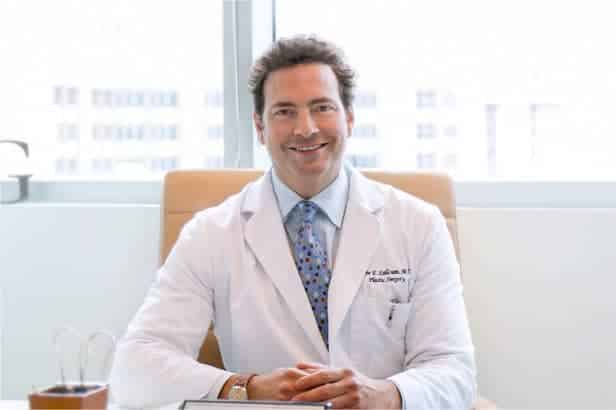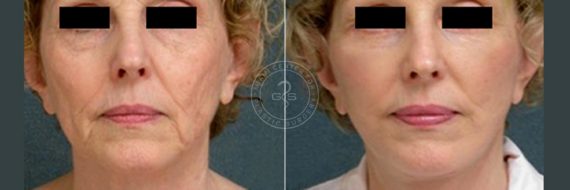Experience the Benefits of a Renewed Look with Facelifts
In an age where personal confidence and youthful vibrancy intertwine, facelifts have emerged as a beacon of aesthetic advancement. This transformative procedure is more than just a change in appearance; it’s a rejuvenation of self-perception and an elevation of self-worth.
Do you want to turn back the clock on signs of aging?
With a facelift, technically known as a rhytidectomy, you can. This comprehensive cosmetic surgery helps minimize signs of aging in the lower part of the face and neck for long-lasting rejuvenation.

What is a Facelift?
A facelift is a classic plastic surgery that rejuvenates the facial tissues in the lower third of the face. The goal of the surgery is to correct signs of aging like sagging and loose skin, deep creases near the mouth and nose, jowls, and facial volume loss.
Although many non-surgical procedures are available (like dermal fillers) to minimize some signs of aging or correct concerns like deep wrinkles and fine lines, no option can provide the same in-depth results as a facelift in both men and women.
After a rhytidectomy, you might look as much as a decade younger.
Are you a candidate for a Facelift?

Your candidacy for rhytidectomy depends mainly on your health and the signs of aging you’re experiencing. There’s no minimum age for the surgery, as long as your aesthetic goals line up with what the procedure can deliver. Some people are good candidates for rhytidectomy in their 40s while others might not be good candidates for the surgery until they are in their 60s or 70s.
If you have started to notice that the skin in the lower part of your face is loose or drooping, or you’re concerned about the development of jowls or deep creases near your mouth, then facelift surgery might be ideal for you. You should only have the surgery to make yourself happy, not to please someone else.
Your overall health plays a role in determining whether any type of plastic surgery is safe for you. The ideal candidate for rhytidectomy will be in good health and have realistic expectations.
It’s also important to note that you should not smoke or use other tobacco products if you are considering plastic surgery. If you do, you’ll need to quit well in advance of the surgery and during the recovery period. Staying smoke-free after your surgery will also help to preserve your results.
CALL TODAY TO SCHEDULE YOUR CONSULTATION
Are there different types of Facelifts?
Every procedure is fully customized based on the needs of the facelift patient. Dr. Salloum takes into account your facial structure, goals, and other concerns when discussing the process with you. Several different types of facelift surgery are available. These include:
- Mini facelift
- Mid-face lift
- Lower facelift
The primary differences between these surgeries are the treatment area and the extent of the changes. A mini facelift makes a few, subtle changes. The recovery is often shorter, but the results aren’t as dramatic as other options. A mid-facelift makes changes in the cheek area. A lower facelift focuses on the chin, jawline, and often, the neck.
Standard Facelift
A standard or full facelift is a typical treatment option if all four characteristics of an aging face are present. In this procedure, the facial muscles are tightened and repositioned to the upper and back portions of the face. This removes excess skin, and the incisions are hidden in the contour of the ear, earlobe, and hairline. It is the most aggressive of all the facelift procedures and will require additional surgeries and recovery time.
Mini Facelift
If your primary concerns are loss of skin elasticity and a tired facial appearance, a mini-facelift can lift and tighten the skin with shorter recovery time and smaller incisions. Compared to a traditional facelift, a mini-facelift has limited or no work on the neck and is best suited for a younger patient.
Short Scar Facelift
A short scar facelift, or an Extended Minimal Access Cranial Suspension Lift (Extended MACS), is a less invasive version of a mini facelift. It lifts the skin vertically and leaves fewer scars. This cosmetic procedure is typically recommended for those with mild or moderate skin laxity and howling.
Facelift Before and After Pictures
*All patients are unique and individual results may vary.
What happens during an initial Facelift consultation?
Your facelift consultation in Miami with Dr. Salloum is an opportunity to get to know each other. It’s also an opportunity to learn more about the surgery and find out what you can expect.
During the consultation, Dr. Salloum will ask about your medical history. He’ll perform a comprehensive evaluation of your face and take pictures for comparison purposes. He’ll also ask you about your goals and will explain the surgical and non-surgical options available to you.
Feel free to prepare a list of questions to ask during your consultation. If you have additional questions after your first meeting with Dr. Salloum, don’t hesitate to get in touch.
Getting Prepared for a Facelift Procedure
Dr. Salloum will provide you with specific instructions to help you prepare for your facial rejuvenation surgery. Generally speaking, you might be asked to stop taking some prescription and OTC medications, such as ibuprofen and blood thinners, as well as certain vitamins or herbal supplements, a few days or weeks before your procedure.
You might also want to prepare your home for the recovery period after surgery. Find someone to drive you to and from the surgical center in Miami Beach, FL. You should also have someone stay with you for the first few days after your facial plastic surgery.
Since you’ll need to take time off from work and other physical activities, put in your time off request well in advance or find someone to cover your shifts. You might also need to reschedule your hobbies and other responsibilities.
To help recovery go smoothly, prepare your home in advance. Have plenty of pillows and blankets ready on the bed or in a recliner and stock your fridge and freezer with easy-to-prepare or “heat and eat” meals. It’s also a good idea to have some fun, but quiet, things to do while you recover. A good book or a TV series will keep you occupied and entertained as you rest up.
What occurs during a Facelift Surgery
You’ll be given anesthesia at the start of your rhytidectomy procedure. Usually, the surgeon will use general anesthesia, so that you’ll be completely under for the whole process. You won’t feel any discomfort or remember anything about the procedure after the surgery is over.
Dr. Salloum will start by making a small incision, usually, in the hairline, which may extend down around the ears. The exact location and size of the incision will depend on the type of facial surgery. Afterward, any scars are usually concealed by the hair or ears.
During the procedure, Dr. Salloum will reposition and tighten the facial skin and underlying deeper tissues. He’ll likely remove excess skin and fat deposits, as well. The exact changes he’ll make will depend on the extent of the aging process and your goals.
Aftercare for a Facelift
Usually, the initial recovery after facial rejuvenation surgery takes between one and two weeks. You’ll most likely want to stay at home during the initial recovery period.
You’ll go home on the day of your surgery, once the anesthesia has worn off. The day after surgery, you might go back to Dr. Salloum for a follow-up visit. During the follow-up appointment, the facelift surgeon might change your dressing, inspect your incision, and ask how you feel. He’ll most likely give you additional post-op instructions about diet and other concerns at that time, and will answer any questions you might have.
One thing to remember during the initial recovery time is to keep your head elevated. Sitting upright and sleeping on your back, with your head propped up, will help to bring down the swelling in your healing process. You can also use ice packs to help minimize swelling or bruising after your facelift. Remember to follow all the instructions to keep your facelift results.

Are there risks to a Facelift?
All surgeries have risks, but there are things you can do to minimize the risk of complications during and after surgery. Following any pre- and post-operative instructions your surgeon provides will help you enjoy a safe and easy recovery process and will improve your facelift results.
After a rhytidectomy, it’s common to have some side effects, particularly swelling and bruising. These side effects will subside gradually. They are likely to be the most noticeable starting a few days after surgery. Several weeks or months later, they will have decreased considerably.
You might experience some discomfort or pain after surgery. Dr. Salloum can prescribe medication to help you manage the pain. Only take pain medication as directed and only as much as you’re prescribed.
Can you combine a Facelift with other surgeries?
Many patients decide to combine a facelift with other rejuvenation procedures to help reduce signs of aging in multiple areas of the face. Some patients decide to have a facelift performed with a neck lift to fully rejuvenate the lower part of the face and neck. Others combine their facelift surgery with a procedure that rejuvenates the upper part of the face, such as a Brow Lift Miami or eyelid surgery.
After your surgery, you might be interested in non-surgical treatments to help prolong your results and to help keep you looking youthful and refreshed. Laser skin resurfacing, dermal fillers, and photo facials can all help to hold off visible signs of aging after surgery.
You can discuss other surgeries with Dr. Salloum during your consultation.
Why should I choose Dr. Gabriel Salloum?
- Dr. Salloum is board-certified by the American Board of Plastic Surgery and the American Board of Surgery
- Specializes in reconstructive surgery, as well as ultrasound-assisted liposuction, facial restructuring, and body contouring
- More than 13 years of experience performing plastic surgery
- Passionate about helping men and women meet their cosmetic goals and become more confident in their own skin
- Provides natural-looking cosmetic results
- Takes the time to get to know each patient and answers any questions before creating a unique surgical plan
- Offers a full range of plastic surgical procedures, including facelifts, upper arm lift surgery, body contouring, liposuction, tummy tucks, thigh lifts, Brazilian butt lifts, and breast reconstruction
- Has achieved a large number of 4.5 and 5-star reviews on Yelp, Vitals, RealSelf, and Google
- Named a New York Times Best Plastic Surgeon

Frequently Asked Questions about Facelift
During a facelift, you’ll be given anesthesia so that you won’t feel anything. Usually, general anesthesia is used, but your surgeon might use a local anesthetic to numb the area, combined with a sedative to help you relax.
During the surgery, Dr. Salloum will make an incision, which will leave a scar. The location of the incision means that you’ll most likely be able to hide it within your hair. In some cases, the incisions are located behind the ears.
Initial recovery after a facelift usually takes anywhere from one to two weeks. You might feel ready to return to work after one week, or you might prefer to take a full two weeks off. When you’ll be ready to go back to work will depend on the type of work you do and how comfortable you are with your colleagues seeing you before you’re completely healed.
Although you can and should take short walks around the house starting a day or two after surgery, it’s best to avoid strenuous activities and major workouts during the first few weeks of recovery. Usually, people are ready to return to sports and other vigorous forms of exercise four to six weeks after a facelift.
The visible results following a facelift will depend on the individual, but most people can expect to start seeing some improvement within 2-4 weeks. The full effects of the surgery may take several months or longer to become fully realized. It’s important to remember that everyone heals differently, so your timeline could vary from this.
Yes. Dr. Salloum is a board-certified plastic surgeon who specializes in producing natural results after a facelift and other surgeries, including reconstruction surgery. He will follow the natural contours of your face to rejuvenate your appearance. You can feel confident that you’ll look youthful and refreshed, without looking “windblown” or artificial.
If you live near Miami Beach, FL, Miami Center For Plastic Surgery offers facelift among its services, and is conveniently located at 4308 Alton Road #720 Miami Beach, FL 33140








